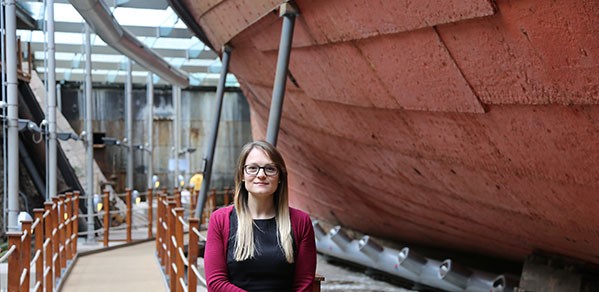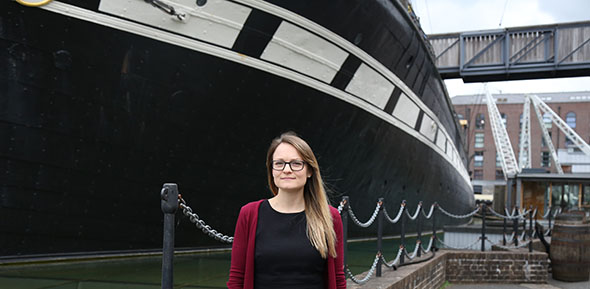
Chartered Mechanical Engineer Nicola Grahamslaw (St Catharine’s, 2008) has been named by The Telegraph as one of its ‘Top 50 Women in Engineering’ for 2018.
I’m really flattered to be included in the list. Returning from an extended break or changing career can both seem quite daunting, so I’m hoping that seeing so many women who have made a success of it will inspire others to give it a go, as it’s very rewarding.
Alumna Nicola Grahamslaw
Compiled in collaboration with the Women’s Engineering Society (WES), the list features the UK’s top rising female stars of engineering. This year's list focused on ‘transferrers and returners’; women who have either taken career breaks or transferred from one industry to another.
Alumna Nicola, who has a background in computational analysis of fluid dynamics and heat transfer, as well as systems engineering consulting experience, took a career break a few years ago to travel to New Zealand. This then led to her becoming more involved in outreach work and resulted in a temporary job in digital technology education.
Nicola was recently appointed by the SS Great Britain Trust as the Ship’s Conservation Engineer, a new role which will see her take responsibility for the conservation of Isambard Kingdom Brunel’s SS Great Britain – the first ocean-going ship to be constructed from iron.
The ship is conserved as a visitor attraction in the original Bristol dry dock in which she was built, using a bespoke climate control system to prevent corrosion. Nicola is working to improve the energy efficiency of the current solution while leading research to develop a longer-term sustainable conservation strategy. She is also assisting with engineering outreach, sharing the Trust’s research on conservation with a wider audience and using Brunel’s work to inspire future engineers.
Hi Nicola, how does it feel to feature in the Telegraph’s ‘Top 50 Women in Engineering’ list?
I’m really flattered to be included in the list. Returning from an extended break or changing career can both seem quite daunting, so I’m hoping that seeing so many women who have made a success of it will inspire others to give it a go, as it’s very rewarding.
In addition, some of the most innovative engineering projects I’ve come across are those which use technology developed for one industry and then apply it in another. Encouraging people to communicate and move between different fields during their career is a great way to facilitate this transfer of ideas.
What did you enjoy most about your Cambridge degree?
I did the Engineering Tripos, specialising in Aerospace and Aerothermal Engineering for part IIA and Energy and the Environment for part IIB. I loved the variety.
The reason I chose the Cambridge course over others was because there’s no specialism until the third year. I went to a state comprehensive school with not much access to careers advice and didn't have any family in STEM careers, so I didn’t know much about engineering when I left school. I liked having two years to try different areas before deciding what to focus on.
What did your journey from graduate to Chartered Mechanical Engineer involve?
I started out in computational analysis of fluid dynamics and heat transfer, designing components for different aerospace clients and projects. I then got involved in some advanced gas-cooled reactor (AGR) safety and life extension work, again specialising in fluids and heat transfer.
As my skills and confidence developed, I progressed into a technical lead role, planning and project managing multi-disciplinary teams of engineers, communicating with stakeholders and helping clients to use analysis to inform project strategy. An advantage of working for a small consultancy is the opportunity to work in different areas such as business development. I also helped to plan and deliver part of the graduate training programme. This variety of experience, combined with the IMechE's (Institution of Mechanical Engineers) four-year structured professional development scheme, meant I felt pretty well-prepared for the CEng application and interview.

Credit: SS Great Britain Trust
What appealed to you about the Conservation Engineer post at SS Great Britain Trust?
The idea of combining engineering problem-solving, research, project management and outreach in such a unique setting really appealed to me. It was exciting to be offered the job. It's a new, one-of-a-kind role, and I've gone from working with teams of engineers to being the first and only Conservation Engineer on this project; a completely different kind of responsibility.
It was also great to know that the skills I had developed were transferable and relevant to what, on the face of it, initially seemed to be a very different job. I've found it really interesting to learn how much nuclear power stations and Victorian ships actually have in common.
What does it take to become a Conservation Engineer?
Conservation of existing objects requires a different approach from designing new ones. Historic structures, in particular, often perform very different functions to those they were designed for; as well as the original design and materials, a Conservation Engineer needs to consider the history of modifications, repairs and use to really understand the object.
An interest in investigative analysis and applying engineering principles to new or non-traditional problems would be really useful here. For my particular role, I think my love of getting stuck in and trying new things, combined with experience communicating with non-engineers and using technical information to help with strategic decision-making also helped me to get the job.
What is your advice to others considering a career in engineering?
The variety of options available in engineering is huge, so I’d encourage people to speak to as many engineers as possible about what they do – most people love being asked about their work! Proactively offer to contribute to things that interest you. Some of my most exciting opportunities have come from being proactive rather than waiting to be asked to get involved with something.
If a project you find yourself working on isn't quite what you had in mind for your dream job, focus on developing the transferable skills which can help move you towards where you want to be. Finally, never be afraid to change your mind about your career path!

